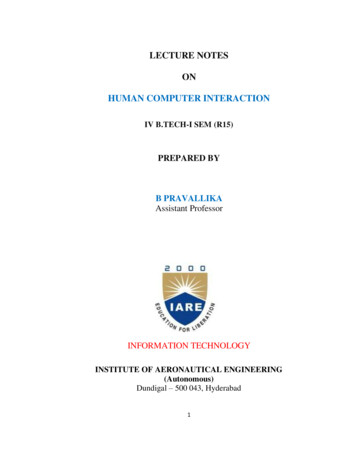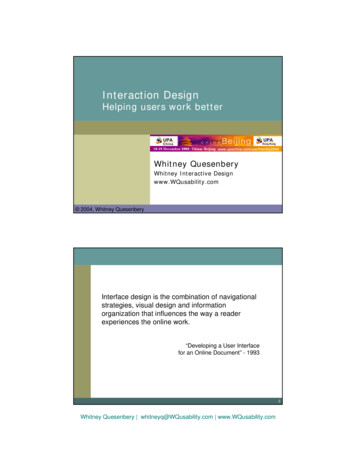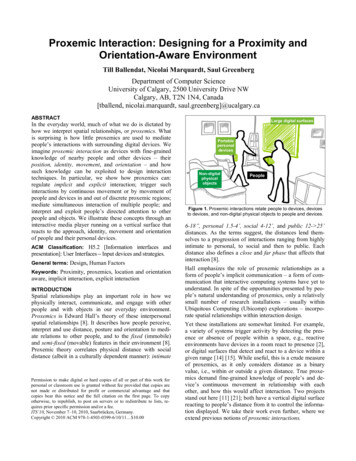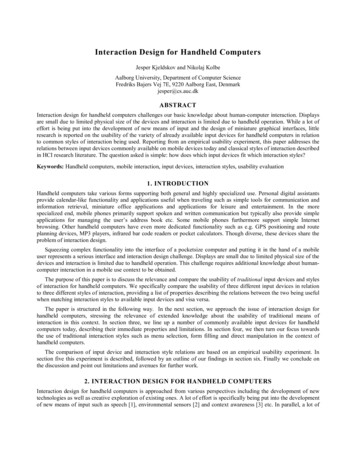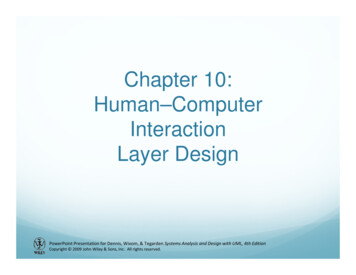
Transcription
Chapter 10:Human–ComputerInteractionLayer DesignPowerPoint Presentation for Dennis, Wixom, & Tegarden Systems Analysis and Design with UML, 4th EditionCopyright 2009 John Wiley & Sons, Inc. All rights reserved.
Objectives Understand several fundamental user interface (UI) design principles.Understand the process of UI design.Understand how to design the UI structure.Understand how to design the UI standards.Understand commonly used principles and techniquesfor navigation design.PowerPoint Presentation for Dennis, Wixom, & Tegarden Systems Analysis and Design with UML, 4th EditionCopyright 2009 John Wiley & Sons, Inc. All rights reserved.
Objectives (cont’d) Understand commonly used principles and techniquesfor input design. Understand commonly used principles and techniquesfor output design. Be able to design a user interface. Understand the effect of nonfunctional requirements onthe human-computer interaction layer.PowerPoint Presentation for Dennis, Wixom, & Tegarden Systems Analysis and Design with UML, 4th EditionCopyright 2009 John Wiley & Sons, Inc. All rights reserved.
Introduction Interface Design defines how the system will interactwith external entities (e.g., customers, users, othersystems) System Interfaces are machine-machine and are dealt with aspart of systems integration User Interfaces are human-computer and are the focus of thischapter Principles for UI designThe UI design processNavigation, Input, Output DesignMobile & social media UI designNon-functional requirements and UI designPowerPoint Presentation for Dennis, Wixom, & Tegarden Systems Analysis and Design with UML, 4th EditionCopyright 2009 John Wiley & Sons, Inc. All rights reserved.
Principles of User InterfaceDesign Layout of the screen, form or report Content Awareness—how well the user understands the information containedAesthetics—how well does it appeal to the userUser Experience—is it easy to use?Consistency—refers to the similarity of presentation indifferent areas of the applicationMinimal User Effort—can tasks be accomplishedquickly?PowerPoint Presentation for Dennis, Wixom, & Tegarden Systems Analysis and Design with UML, 4th EditionCopyright 2009 John Wiley & Sons, Inc. All rights reserved.
Layout The arrangement of items on the screen Like items are grouped into areas Areas can be further subdivided Each area is self-contained Areas should have a natural intuitive flow Users from western nations tend to read from left to right and top tobottom Users from other regions may have different flowsPowerPoint Presentation for Dennis, Wixom, & Tegarden Systems Analysis and Design with UML, 4th EditionCopyright 2009 John Wiley & Sons, Inc. All rights reserved.
General LayoutNavigationAreaReports &FormsAreaStatusAreaPowerPoint Presentation for Dennis, Wixom, & Tegarden Systems Analysis and Design with UML, 4th EditionCopyright 2009 John Wiley & Sons, Inc. All rights reserved.
Content Awareness Applies to the interface in general, to each screen, toeach area on a screen and to sub-areas as well Include titles on all interfaces Menus should show where the user is and how theuser got there All areas should be well defined, logically groupedtogether and easily discernible visuallyPowerPoint Presentation for Dennis, Wixom, & Tegarden Systems Analysis and Design with UML, 4th EditionCopyright 2009 John Wiley & Sons, Inc. All rights reserved.
Aesthetics Interfaces should be functional, inviting to use, andpleasing to the eye Simple minimalist designs are generally better White space is important to provide separation Acceptable information density is proportional to theuser’s expertise Novice users prefer lower density ( 50%) Expert users prefer higher density ( 50%) Text design: size, serif vs. sans serif, use of capitals Color and patterns (e.g., don’t use red on blue )PowerPoint Presentation for Dennis, Wixom, & Tegarden Systems Analysis and Design with UML, 4th EditionCopyright 2009 John Wiley & Sons, Inc. All rights reserved.
High Density ExamplePowerPoint Presentation for Dennis, Wixom, & Tegarden Systems Analysis and Design with UML, 4th EditionCopyright 2009 John Wiley & Sons, Inc. All rights reserved.
User Experience Ease of learning Significant issue for inexperienced users Relevant to systems with a large user population Ease of use Significant issue for expert users Most important in specialized systems Ease of learning and use of use are related Complementary: lead to similar design decisions Conflicting: designer must choose whether to satisfy novices orexpertsPowerPoint Presentation for Dennis, Wixom, & Tegarden Systems Analysis and Design with UML, 4th EditionCopyright 2009 John Wiley & Sons, Inc. All rights reserved.
Consistency Extremely important concept in making the systemsimple It allows the users to predict what is going to happen All parts of the system work in the same way Users learn how one portion works and immediately apply it toothers Key areas of consistency are Navigation controls Terminology—use the same descriptors on forms & reportsPowerPoint Presentation for Dennis, Wixom, & Tegarden Systems Analysis and Design with UML, 4th EditionCopyright 2009 John Wiley & Sons, Inc. All rights reserved.
Minimal User Effort Interfaces should be designed to minimize the effortneeded to accomplish tasks A common rule is the three-clicks rule Users should be able to go from main menu of a system to theinformation they want in no more than three mouse clicksPowerPoint Presentation for Dennis, Wixom, & Tegarden Systems Analysis and Design with UML, 4th EditionCopyright 2009 John Wiley & Sons, Inc. All rights reserved.
User InterfaceDesign Process Consists of 5 steps Process is iterative andanalysts may move back &forthPowerPoint Presentation for Dennis, Wixom, & Tegarden Systems Analysis and Design with UML, 4th EditionCopyright 2009 John Wiley & Sons, Inc. All rights reserved.
Use Scenario Development Use scenarios outline the steps performed by users toaccomplish some part of their work A use scenario is one path through an essential usecase Presented in a simple narrative description Document the most common cases so interfacedesigns will be easy to use for those situationsPowerPoint Presentation for Dennis, Wixom, & Tegarden Systems Analysis and Design with UML, 4th EditionCopyright 2009 John Wiley & Sons, Inc. All rights reserved.
Interface Structure Design The interface structure defines The basic components of the interface How they work together to provide functionality to users Windows Navigation Diagrams (WND) Similar to a behavioral state machine Shows the relationship between all screens, forms, and reports used by the systemShows how the user moves from one to anotherBoxes represent componentsArrows represent transitions from and to a calling stateStereotypes show interface typePowerPoint Presentation for Dennis, Wixom, & Tegarden Systems Analysis and Design with UML, 4th EditionCopyright 2009 John Wiley & Sons, Inc. All rights reserved.
Windows NavigationDiagrams Like a state diagram for the user interface Boxes represent components Window Form Report Button Arrows represent transitions Single arrow indicates no return to the calling state Double arrow represents a required return Stereotypes show interface typePowerPoint Presentation for Dennis, Wixom, & Tegarden Systems Analysis and Design with UML, 4th EditionCopyright 2009 John Wiley & Sons, Inc. All rights reserved.
Sample WNDPowerPoint Presentation for Dennis, Wixom, & Tegarden Systems Analysis and Design with UML, 4th EditionCopyright 2009 John Wiley & Sons, Inc. All rights reserved.
Interface Standards Design Interface standards are basic design elements foundacross the system user interface Standards are needed for:– Interface metaphor: defines how an interface will work (e.g., the––––shopping cart to store items selected for purchase)Interface objectsInterface actionsInterface iconsInterface templatesPowerPoint Presentation for Dennis, Wixom, & Tegarden Systems Analysis and Design with UML, 4th EditionCopyright 2009 John Wiley & Sons, Inc. All rights reserved.
Interface Design Prototyping Mock-ups or simulations of computer screens, forms, andreports Four common approaches (listed in increasing detail) Storyboard: hand drawn pictures of what the screens will look like Windows layout diagram: a computer generated storyboard thatmore closely resembles the actual interface HTML prototype: web pages linked with hypertext Language prototype: more sophisticated than HTML Built in the programming language with no real functionality User does not have to guess about the final appearance of the screenPowerPoint Presentation for Dennis, Wixom, & Tegarden Systems Analysis and Design with UML, 4th EditionCopyright 2009 John Wiley & Sons, Inc. All rights reserved.
Interface Evaluation Goal is to understand how to improve the interfacedesign before the system is complete Have as many people as possible evaluate theinterface Ideally, interface evaluation is done while the system isbeing designed—before it is built Help identify and correct problems early Designs will likely go through several changes after the userssee it for the first timePowerPoint Presentation for Dennis, Wixom, & Tegarden Systems Analysis and Design with UML, 4th EditionCopyright 2009 John Wiley & Sons, Inc. All rights reserved.
Approaches to UI Evaluation Heuristic—compare the design to known principles orrules of thumb Walkthrough evaluation—design team presentsprototype to the users & explains how it works Interactive—the users work with the prototype with aproject team member Formal Usability Testing—performed in labs with userson a language prototypePowerPoint Presentation for Dennis, Wixom, & Tegarden Systems Analysis and Design with UML, 4th EditionCopyright 2009 John Wiley & Sons, Inc. All rights reserved.
Common Sense Approach toUser Interface Design Users should not have to think about how to navigatethe user interface The number of clicks should relate to the complexity ofthe task and should be unambiguous Minimize the number of words on the screenPowerPoint Presentation for Dennis, Wixom, & Tegarden Systems Analysis and Design with UML, 4th EditionCopyright 2009 John Wiley & Sons, Inc. All rights reserved.
Navigation Design The component that enables the user to navigatethrough the system Also provides messages of success or failure of actionsperformed Make it simple so that the user never really notices Basic principles: Prevent the user from making mistakes Simplify recovery for the user when mistakes are made Use a consistent grammar order (e.g., File Open vs. Open File)PowerPoint Presentation for Dennis, Wixom, & Tegarden Systems Analysis and Design with UML, 4th EditionCopyright 2009 John Wiley & Sons, Inc. All rights reserved.
Types of Navigation Controls Language Command language—user types in a command to be executed Natural language—system interprets the user’s language Menus User is presented a list of choices Comes in different forms (e.g., menu bars, popups, drop downs) Direct manipulation (e.g., drag and drop)PowerPoint Presentation for Dennis, Wixom, & Tegarden Systems Analysis and Design with UML, 4th EditionCopyright 2009 John Wiley & Sons, Inc. All rights reserved.
Messages How the system informs the user of the status of aninteraction Error messages—user did something that is not permittedConfirmation messages (e.g., “Are you sure?”)Acknowledgment messages (e.g., “Order entered”)Delay messages—provides feedback to the user that theprocess is running Help messages—provides additional information about thesystem to assist the user in performing a taskPowerPoint Presentation for Dennis, Wixom, & Tegarden Systems Analysis and Design with UML, 4th EditionCopyright 2009 John Wiley & Sons, Inc. All rights reserved.
Navigation DesignDocumentation Done using WNDs and real use-cases Real use-cases are implementation dependent Detailed description of how to use the implemented system Essential use-cases evolve into real use cases by specifyingthem in terms of the actual user interfacePowerPoint Presentation for Dennis, Wixom, & Tegarden Systems Analysis and Design with UML, 4th EditionCopyright 2009 John Wiley & Sons, Inc. All rights reserved.
Input Design Screens that are used to input data Data can be structured or unstructured Structured: Dates, names, products, etc. Unstructured: Comments, descriptions Basic principles Online vs. batch processing Capture data at the source (e.g., barcode vs. RFID) Minimize keystrokes (e.g., by using defaults for frequently usedvalues)PowerPoint Presentation for Dennis, Wixom, & Tegarden Systems Analysis and Design with UML, 4th EditionCopyright 2009 John Wiley & Sons, Inc. All rights reserved.
Types of Inputs Free form controls Text boxes for alphanumeric information Number boxes with automatic formatting Example: Enter a phone number as 3451236789; automaticallyformats as (345)-123-6789 Password boxes that hide characters with stars and do notallow cutting or copying Selection boxes Check boxes when several items can be selectedRadio buttons when items are mutually exclusiveList boxes to present a set of choicesSliders—a pointer that can be moved along a scalePowerPoint Presentation for Dennis, Wixom, & Tegarden Systems Analysis and Design with UML, 4th EditionCopyright 2009 John Wiley & Sons, Inc. All rights reserved.
Input Validation Data should be validated prior to entry to ensure accuracy Do not accept invalid data (e.g., input text when a numberis required) Validation checks: CompletenessFormat (e.g. MM/DD/YYYY)Range (e.g. a number falls within a minimum and maximum value)Check sum digit—reduces errors in entering numbersConsistency—data are relatedDatabase check—does not violate entity or referential integrityPowerPoint Presentation for Dennis, Wixom, & Tegarden Systems Analysis and Design with UML, 4th EditionCopyright 2009 John Wiley & Sons, Inc. All rights reserved.
Output Design Reports produced from the data generated by thesystem Basic principles: Report usage and its frequency will affect its layout Manage the information load in a report—provide only what isneeded and place most important information near the top Minimize bias, especially in graphical displays (charts)PowerPoint Presentation for Dennis, Wixom, & Tegarden Systems Analysis and Design with UML, 4th EditionCopyright 2009 John Wiley & Sons, Inc. All rights reserved.
Types of Outputs Detail reports—users need full information Summary reports—details are aggregated (e.g., sums, averages)Exception reportsTurnaround documents—outputs turn around andbecome inputsGraphs—for easy visual comparisonMedia for reports can be electronic (seen on thescreen) or hard copy (printed on paper)PowerPoint Presentation for Dennis, Wixom, & Tegarden Systems Analysis and Design with UML, 4th EditionCopyright 2009 John Wiley & Sons, Inc. All rights reserved.
Mobile Computing andUI Design Smaller devices have limited space, touch screens andhaptic feedback Necessitate design from the ground up, not simplyporting a web interface already designed for a largercomputer Capabilities of devices varies widely and are usedeverywhere under highly variable conditions (ambientlight and noise levels)PowerPoint Presentation for Dennis, Wixom, & Tegarden Systems Analysis and Design with UML, 4th EditionCopyright 2009 John Wiley & Sons, Inc. All rights reserved.
Suggestions for MobileDesign Focus on user needs, not user wants Remove all “fluff” from big websites Utilize the capabilities of the device (e.g., built-in GPS,accelerometers, etc.) Make things vertically scrollable, not horizontally Reduce interactions with the network to the extentpossible Make use of reusable patterns (e.g., vertically stackingweb pages)PowerPoint Presentation for Dennis, Wixom, & Tegarden Systems Analysis and Design with UML, 4th EditionCopyright 2009 John Wiley & Sons, Inc. All rights reserved.
Social Media and UI Design Social media presents alternative opportunities andchallenges Facebook, Twitter, Flickr , YouTube Wikis, blogs Who is the target audience? What is the purpose of the application? (e.g., marketingchannel) Which type of social media works best for your functionalrequirements?PowerPoint Presentation for Dennis, Wixom, & Tegarden Systems Analysis and Design with UML, 4th EditionCopyright 2009 John Wiley & Sons, Inc. All rights reserved.
Guidelines for Social Media Post and update information oftenUse a combination of push and pull approachesKeep your sites synchronized to the extent possibleAllow customers to share your content Provide a voting or “like” mechanism to encourage customersto become involved in your site Design the site for longer term engagement Build a sense of community—users “belong” tosomething Take into account international and cultural issuesPowerPoint Presentation for Dennis, Wixom, & Tegarden Systems Analysis and Design with UML, 4th EditionCopyright 2009 John Wiley & Sons, Inc. All rights reserved.
International & Cultural Issuesin UI Design Websites have a global presence Considerations: Multilingual requirements The meaning of certain colors Cultural differences Power distance Uncertainty avoidance Individualism vs. collectivismPowerPoint Presentation for Dennis, Wixom, & Tegarden Systems Analysis and Design with UML, 4th EditionCopyright 2009 John Wiley & Sons, Inc. All rights reserved.
Non-Functional Requirements Operational Requirements—choice of hardware andsoftware platforms Technologies that can be used (e.g. GUI, 2 or 3 button mouse) Performance Requirements Mobile computing and web browsing inject additionalperformance obstacles Security Requirements Appropriate log on controls and possibly encryption Wireless networks are especially vulnerable Political & Cultural Requirements Date formats, colors, and currenciesPowerPoint Presentation for Dennis, Wixom, & Tegarden Systems Analysis and Design with UML, 4th EditionCopyright 2009 John Wiley & Sons, Inc. All rights reserved.
Summary Principles of User Interface DesignUser Interface Design ProcessNavigation DesignInput DesignOutput DesignMobile Computing and UI DesignSocial Media and UI DesignInternational & Cultural Issues and UI DesignNonfunctional RequirementsPowerPoint Presentation for Dennis, Wixom, & Tegarden Systems Analysis and Design with UML, 4th EditionCopyright 2009 John Wiley & Sons, Inc. All rights reserved.
Interface Design defines how the system will interact with external entities (e.g., customers, users, other systems) System Interfaces are machine-machine and are dealt with as part of systems integration User Interfaces are human-computer and are the focus of this chapter Principles for UI

